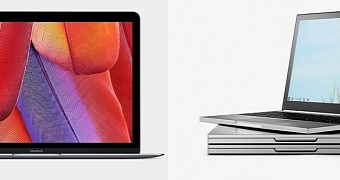Just a few days apart, Apple and Google both unveiled laptops taking advantage of the new and controversial USB Type-C port.
In the case of Apple, the Cupertino tech giant is not only ditching traditional USBs, but it’s also foregoing its own MagSafe charging standard in favor of this new, multipurpose Type-C plug.
The standard was originally announced in later 2013 and shares some similarities with Apple’s Lightning connectors, in a sense that users are able to fit it regardless of the way it is facing.
USB Type-C has been designed to use the same port to charge the laptop, hook up peripherals, connect and charge smartphone or attach an external display.
The new standard can deliver up to 100 watts, which is 10 times more than what an average micro USB cable can deliver.
It can also support data transfer speeds of up to 20Gbs and is compatible with DisplayPort, HDMI and VGA video output.
Apple's new laptop has only one port
But there’s a pretty big caveat while the Type-C plug is concerned. The new MacBook sports a single such connector, thus making it imperative for future Mac users to use accessories (hubs, adapters, dongles) to permit multiple external connections. In an earlier piece, we talked about the adapters you will need to get things done on your new MacBook.
We have to consider that USB is one of the most enduring standards since the ’90 and most electronics today (not only computers) have at least one such connector, with different size variations. But as always, Apple prefers to be at the forefront of change. And Google is not far behind. Albeit the companies’ stances on USB Type-C differ quite a lot.
As I mentioned above, Apple’s new MacBook comes with a singular USB port, while the Chromebook Pixel has several.
By choosing to implement only the Type-C plug, new MacBook users will have to pick up a lot of extra adapters, some of which are sold for as much as $79 / €76.
Forget that the whole concept of portability goes down the drain with having so many extra wires to carry around with you, but it doesn’t look to good that Apple is making you pay extra, considering a new MacBook will cost you at least $1,299 / €1,238.
But the thing is Apple is once ahead of its time, striving towards an era where laptops are cleaner-looking and nearly wire-free, using wireless technology to connect to a display (AirPlay) or other accessories (Bluetooth). And the new Macbook represents the first step.
Google's Pixel has several plugs
Google, on the other hand, took a slightly different approach. The Chromebook Pixel (2015) has two standard USB 3.0 ports, an SD card slot and two (not just one) USB Type-C ports (one living on either side).
That means you can choose to plug in an external monitor AND charge your mobile phone while using the port on the other side.
Yes, for the time being you’ll still need to buy extra adapters to connect the external display and Google like Apple sells those for extra cash.
Google makes a point in highlighting that if you forget your charger at home, but still have a USB Type-C to standard USB connector on you, you can go ahead and charge the Chromebook Pixel via the standard USB charger.
What's more, you’ll be able to charge your new Pixel from another Chromebook Pixel. And while in theory you could run one USB Type-C port into another, Google doesn’t advise you to choose this road.
So as opposed to Apple, who is striving towards a cleaner-looking laptop, Google is using the two new connectors to let you use cables in novel ways.
Google has already promised that USB Type-C ports will make it into future Android mobile devices and Chromebooks, but it’s yet unclear whether Type-C will be coming to Apple’s new iOS devices. Time will tell.

 14 DAY TRIAL //
14 DAY TRIAL //